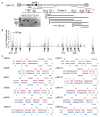Sequence Analysis of microRNAs Encoded by Simian Lymphocryptoviruses
- PMID: 39772230
- PMCID: PMC11680086
- DOI: 10.3390/v16121923
Sequence Analysis of microRNAs Encoded by Simian Lymphocryptoviruses
Abstract
Lymphocryptoviruses (LCVs) are ubiquitous gamma-herpesviruses that establish life-long infections in both humans and non-human primates (NHPs). In immunocompromised hosts, LCV infections are commonly associated with B cell disorders and malignancies such as lymphoma. In this study, we evaluated simian LCV-encoded small microRNAs (miRNAs) present in lymphoblastoid cell lines (LCLs) derived from a Mauritian cynomolgus macaque (Macaca fascicularis) with cyLCV-associated post-transplant lymphoproliferative disease (PTLD) as well as the viral miRNAs expressed in a baboon (Papio hamadryas) LCL that harbors CeHV12. Via sequence comparisons, we further predicted viral miRNAs encoded by LCVs that infect two additional NHP species: stump-tailed macaques (Macaca arctoides) and bonobos (Pan paniscus). Together, these species represent two arms of the primate phylogeny: Hominoids (Pan) and Old-World monkeys (Macaca, Papio). Through our analysis, we defined sequences for >95 viral miRNAs encoded by these four NHP LCVs. Our study provides the most comprehensive annotation of NHP LCV miRNAs to date, yielding a resource for developing sequence-specific reagents to detect these molecules. Importantly, we further demonstrate that cyLCV miRNAs can be detected in circulation in vivo and have biomarker potential for LCV-related PTLD.
Keywords: biomarkers; herpesvirus; lymphocryptovirus; microRNAs.
Conflict of interest statement
The authors declare no conflicts of interest.
Figures






Similar articles
-
A model of lymphocryptovirus-associated post-transplant lymphoproliferative disorder in immunosuppressed Mauritian cynomolgus macaques.PLoS Pathog. 2024 Nov 11;20(11):e1012644. doi: 10.1371/journal.ppat.1012644. eCollection 2024 Nov. PLoS Pathog. 2024. PMID: 39527641 Free PMC article.
-
The genomic sequence of lymphocryptovirus from cynomolgus macaque.Virology. 2016 Jan 15;488:28-36. doi: 10.1016/j.virol.2015.10.025. Epub 2015 Nov 17. Virology. 2016. PMID: 26590795
-
Non-human Primate Lymphocryptoviruses: Past, Present, and Future.Curr Top Microbiol Immunol. 2015;391:385-405. doi: 10.1007/978-3-319-22834-1_13. Curr Top Microbiol Immunol. 2015. PMID: 26428382 Review.
-
Quantitative PCR assays reveal high prevalence of lymphocryptovirus as well as lytic phase gene expression in peripheral blood cells of cynomolgus macaques.J Virol Methods. 2014 Oct;207:220-5. doi: 10.1016/j.jviromet.2014.07.015. Epub 2014 Jul 24. J Virol Methods. 2014. PMID: 25064358
-
Simian homologues of Epstein-Barr virus.Philos Trans R Soc Lond B Biol Sci. 2001 Apr 29;356(1408):489-97. doi: 10.1098/rstb.2000.0776. Philos Trans R Soc Lond B Biol Sci. 2001. PMID: 11313007 Free PMC article. Review.
References
Publication types
MeSH terms
Substances
Associated data
Grants and funding
LinkOut - more resources
Full Text Sources

